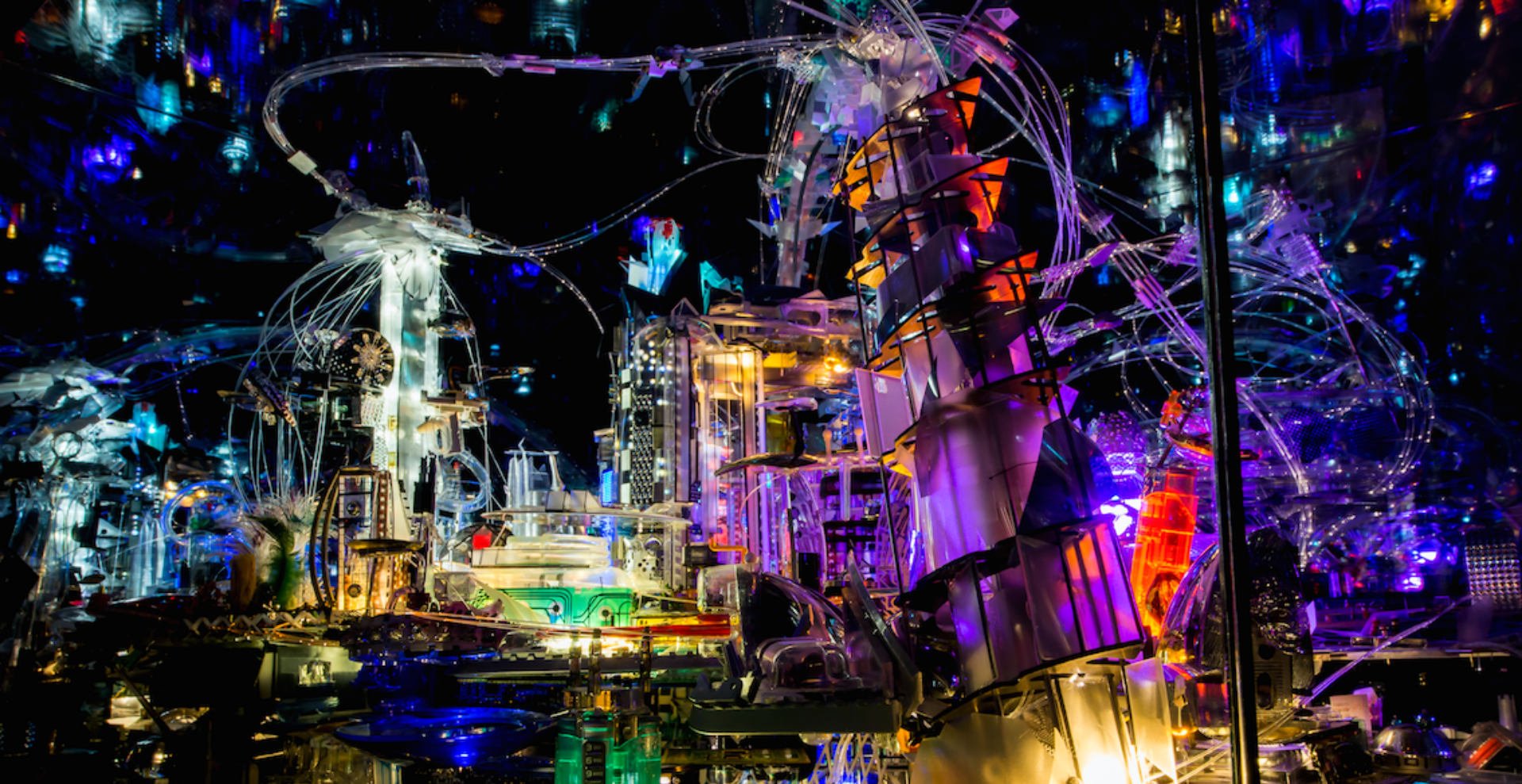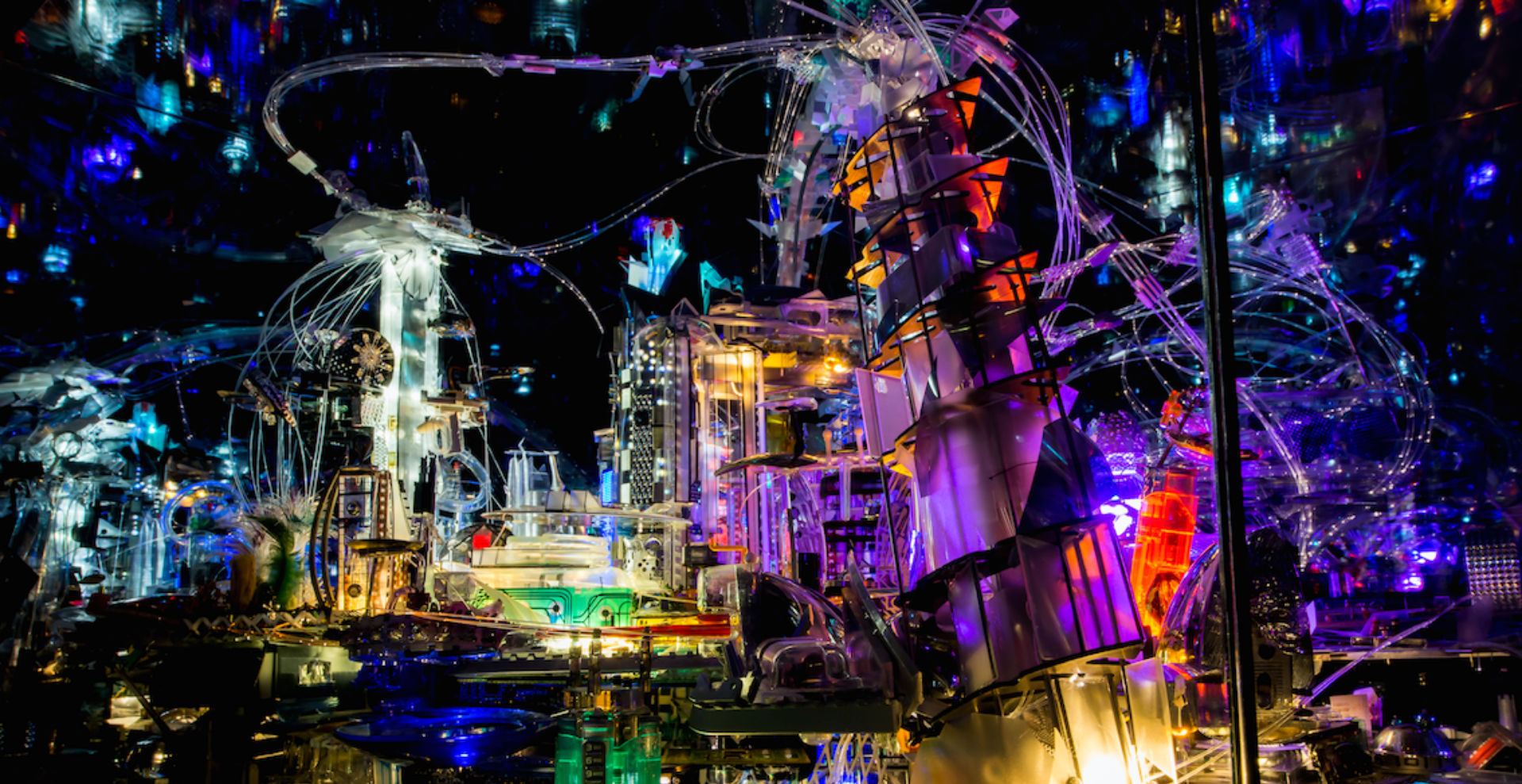
The seas are full of plastic, Australia is burning and the rainforest is vanishing. So our hopes turn towards the Red Planet, and a chance to start again.
The Mars & Beyond exhibition takes place over five floors of the Bargehouse on London’s South Bank. Visual artist Oskar Krajewski has gathered over forty artists, who work in a range of styles, to take part in this exhibition. Their creative contributions encompass film, sculpture and sensory experiences.
I should start by stating that I came to this exhibition with a theatre hat on, expecting an immersive experience. Instead I enjoyed a few hours looking at some great art.
Krajewski told me that he has designed what he calls “theatre in a box,” where LED covered sculptures looking like futuristic cities are contained within a box. Using headphones we could listen to descriptions of the cities of Mars in 2041, run by corporations and surveyed by drones. When I asked how he felt about technology, considering the fear shown by some of the works in the exhibition, he stated that “technology is a tool we need to use wisely.”
There are a variety of pieces that can be interacted with. “Travellers on the Rounded Wave” are large inflatable aliens with wooden levers which allow air to blow into bottles to make music. “Humanoid Communication Device” is an organ that connects to play a range of household tools, such as drills or vacuums. The noise of the latter screeched down the halls and gave me a start, before I encountered the exhibit.
I spent a good amount of time in the bar area entertained by Mickey, a man who was running a radio show. We sat around a circular table with him in the centre asking questions. Would we go to Mars? If we could, then would we upgrade ourselves? Was makeup upgrading? I suggested that the use of glasses and hearing aids could already be classified as upgrading and that I would gladly become a cyborg, just for the moral quandaries I would encounter. Since I spend a lot of time thinking about hypothetical narratives and moralities, I was more than ready to debate the inherent classism and eugenics that come from a group inherently “improved.” This remained one of my favourite sections of the exhibition, particularly for the way Mickey would beg passing people to come and join him.
A highlight for me was Klaudia Olender’s performance art piece “#GarbagePrincess.” She sits before an empty chair, in a dress of trash designed by Charlina Lucas, breathing from an oxygen cylinder. Sitting facing her she stares at you unblinking, judging but a little sad. At last I had found something I could safely say I understood. A Marina Abramović-style piece of silent performance art looking at a corrupted Gaia.
Get Thomas Jancis’s stories in your inbox
Join Medium for free to get updates from this writer.
SubscribeSubscribe
This fear for our future and mankind’s destruction was evident from the presence of Greenpeace at the exhibition. On the ground floor was a tent where we could put on Virtual Reality goggles in order to watch videos of the charity’s ongoing efforts to help clean up the ocean, with the hope of protecting 30% of the ocean by 2030. The current level of achievement is only 3%. They also had an exhibition of various artefacts from protests, such as placards and chains.
There was a strange amount of technophobia in some of the pieces, suggesting how technology is ruining us and everything is Black Mirror-lite. Having worked with augmented reality myself and maintaining many long distance friendships over social media I would jump to defend technology. It is too easy to badmouth it.
People observing the exhibition complained that phones separate us as individuals in a community while I find technology keeps me closer to people I care about, even the ones who live down the road. Some of my friends make works of audio fiction that are spread across the globe. We have a united comradeship through this. People on public transport, before they had mobile phones, would often have a book or a newspaper to read or just loudly hum in order to avoid this so-desired human contact.
At present I am working on a show about what happens when the ocean takes revenge for our mistreatment of her over the decades. Thus I viewed this exhibition through this lens and found I was drawn more to the work about conservation and ocean preservation than the dancing spaceman.
Once again we could go back to arguing about what is classified as “immersive.” But the exhibition asks important questions and I think it is worth dedicating a few hours to exploring.
While we still have time.
MARS & BEYOND will be running in London until 15 March 2020; Kids £5, students £8–12 and adults £15–20.
NoPro is a labor of love made possible by our generous Patreon backers. Join them today!
In addition to the No Proscenium web site, our podcast, and our newsletters, you can find NoPro on Twitter, Facebook, YouTube, Instagram, in the Facebook community Everything Immersive, and on our Slack forum.
Office facilities provided by Thymele Arts, in Los Angeles, CA.





















Discussion